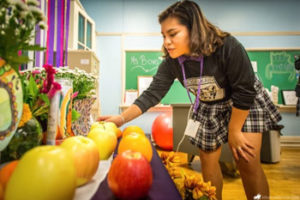St. Louis Review: Dia de los Muertos
Dia de los Muertos becomes new tradition at Rosati-Kain
By Jennifer Brinker | [email protected] | twitter: @jenniferbrinker
For a printer-friendly version of the story, please click here.
Next week when her friends go to Halloween parties and trick or treating, Vivian Garcia Cruz will be celebrating with her own culture’s tradition of honoring the dead.
Garcia Cruz and several of her classmates at Rosati-Kain High School last week set up an altar to celebrate Dia de los Muertos (Day of the Dead), a Mexican tradition to commemorate the lives of deceased loved ones.
The celebration is popular in Mexican culture, and typically lasts several days, beginning on Halloween and concluding on Nov. 2, the feast of All Souls.
 As a senior and president of the school’s Diversity Club, Garcia Cruz wanted to share the tradition with her school community as a parting gesture. She sent out an email to other Hispanic students to enlist their help. They began setting up the altar Oct. 17 in the school’s campus ministry room, decorating it with bright tablecloths and flowers. The centerpiece is a statue of the Blessed Mother; students also set out candles, fruit and pan de muertos, a traditional sweet bread.
As a senior and president of the school’s Diversity Club, Garcia Cruz wanted to share the tradition with her school community as a parting gesture. She sent out an email to other Hispanic students to enlist their help. They began setting up the altar Oct. 17 in the school’s campus ministry room, decorating it with bright tablecloths and flowers. The centerpiece is a statue of the Blessed Mother; students also set out candles, fruit and pan de muertos, a traditional sweet bread.
When she started as a freshman, Garcia Cruz was one of two Hispanic students at the all-girl school. Now as a senior, the Hispanic population has grown to about 7.5 percent. Garcia Cruz, whose family is from the southern Mexican state of Oaxaca, spoke of the importance of sharing her cultural traditions at school.
In Mexico, the altar for the dead is traditionally set up in the cemetery, where a celebration of the lives of the deceased takes place. “It’s different from the American perspective that the dead are scary, the dead are coming back to haunt you,” Garcia Cruz said. “Our dead are very loved, and we respect that they’re coming back to life once again. We stay all night at the cemetery and have food. There’s a lot of music. It’s a huge party.”
Mexican families living in the United States often set up altars in their homes, and place upon it photos of their deceased loved ones and symbols of some of the things they loved — food and drink or hobbies, for example.
Students were invited to make miniature Day of the Dead shrines out of shoeboxes, which will be placed on the altar. Garcia Cruz made one for her uncle, Luis, who died three years ago. Her uncle loved pizza, soccer and beer — and those were some of the items her family placed on their home altar.
Junior Paula Bautista celebrated Dia de los Muertos with her family last year in the western Mexican state of Michoacán. It was the last time she got to celebrate with her grandmother, who passed away the following summer at the age of 98. “We set up an altar, and we went to the main square and celebrated there,” she said. “We celebrate the good life that they had and their achievements.”
